For some time we have been aware of a technique for striking cuttings of very young black pine seedlings by cutting the stem at where it changes to purple and striking the top as a cutting. This is supposed to give better root structure to the resulting plant. I have trialled this but in my opinion the technique is slower, makes more work and the results are no better than using well root pruned seedlings.
I do, however, routinely prune my black pine seedlings to force low shoots that will give options for branching and can help to thicken the base of the resulting tree. Without early pruning you get a long, thin trunk with no low shoots.
This year after pruning the seedlings I recognised that the left over tops were the ultimate in juvenile pine growth and decided to test the rooting ability. The results were very good as shown in the step by step pics below.
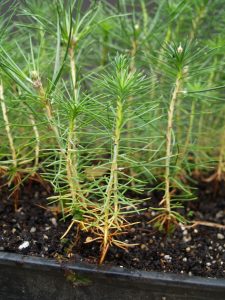
JBP seedlings
Typical Japanese Black Pine seedlings at a couple of months old.
Timing is not critical.
Cuttings can be taken from pine seedlings whenever the seedling is tall enough to give a cutting long enough to handle and right through to when the adult, paired needles develop.
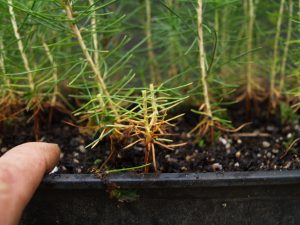
Chop the tops
The tops of the seedlings are cut with sharp scissors. Provided I leave some healthy green needles those stems will produce new buds and continue to grow.
Low shoots are very useful in pines so chopping the seedlings is a valuable tool even if you don’t intend to make cuttings.
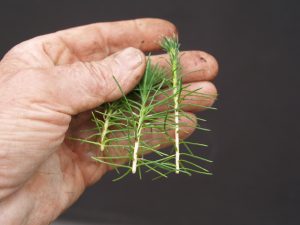
Typical JBP juvenile growth cuttings
Typical JBP seedling stem cuttings.
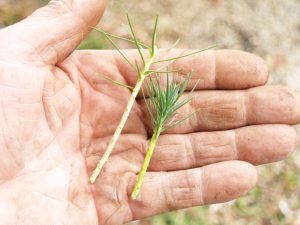
Strip lower leaves
Strip the lower foliage as you would for most cuttings.
Note the cutting with intact terminal bud on the right. Where the seedlings are taller I can sometimes get 2 pieces from the stem. Cutting on the left is from the lower section and doesn’t have a terminal bud but still has a good chance of producing roots and new buds from the remaining needles.
The prepared cuttings are now dipped in rooting hormone. I get good results with Clonex gel but rooting hormone in any form should give good results. I have not tried other treatments so if you prefer to use honey or any of the other alternative root promoting substances please let us know how they work with pines. It would also be interesting to hear how these JBP cuttings root without any treatment.
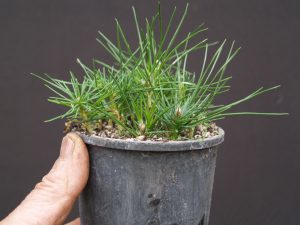
Community pot of JBP cuttings
The cuttings are now potted up in standard propagating mix.
They will now go into the cutting bed under automatic misting until roots form. If you don’t have misting you should still get good results by covering the cuttings with a plastic bag, PET bottle or any standard humidity control options.
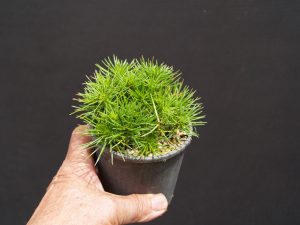
After some weeks the cuttings are still healthy.
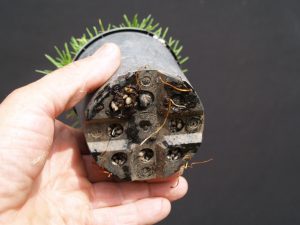
Roots showing at drain holes
Roots are now emerging from the drain holes in the pots so it is clear the cuttings are successful.
These are now ready to pot on into individual pots.
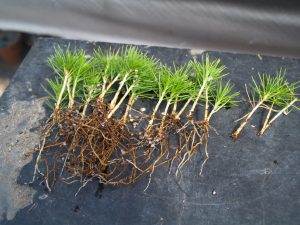
The results
Only 3 of these cuttings have failed to produce roots. They can be discarded but if I put them back in fresh propagating mix and back in the misting bed they will often produce roots in a few more weeks.
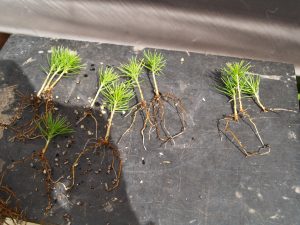
Roots at a range of stages
I usually get a range of root developments. Some have lots of roots, some just a few. Some will have long roots while others have just started and have shorter roots.
New roots on cuttings are fragile so handle with care at this stage to avoid breaking the new roots off the stems.
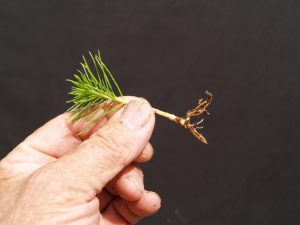
Cut roots short.
The rooted cuttings can be potted on with roots intact but to enhance the future nebari even more I often cut the new roots short. Cutting roots at this stage will produce more root ramification from the cut ends and often stimulate more roots from the stem.
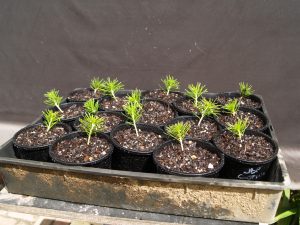
Rooted cuttings potted on.

Pingback: Japanese Black Pine Cuttings. | Nichigo Bonsai
Do you think the same technique would work on japanese white pines?
Hi Christopher, Thanks for your interest. I have no doubt that this technique will work on all plants. One of the basic premises in growing cuttings is the younger the material the easier and quicker it will root. I believe that white pines are a bit easier to grow from mature cuttings. The variety ‘Zushio’ is always grown from cuttings and I have struck some cuttings from pieces taken home from club workshops. Just can’t keep them growing for more than a few years due to our severe summers.
Hi there
Very impressive . I have not heard of your 2 for 1 technique . Makes great sense. Now in Aussie how do you provide a cold spell (60 days) in order for your pines to have a little rest every year. Will they not just burn out after a few years without that needed rest. I am on my way to Japan on Tuesday for a month . If you want I can buy seed of any of the junies and pines and off them to you. The seed comes in sterilized packs so is legal to import at least it is here in Canada. Drop me a line.
Good luck
Brian
Hi Brian, Hope you enjoy the trip. Australia is a big palce covering many climate zones. I live in the south with 4 distinct seasons and winter temps regularly down to 3 below feezing and occasional nights 7 below. That said, black pines are pretty adaptable and growers in tropical areas of QLD grow them successfully. I have not been able to grow white pines successfully. i think it is just too hot here in summer for them.
Thanks for the offer of seed but imported seed needs a phytosanitary certificate to ensure it does not carry any of the diseases we don’t already have and could endanger our tree growing industries. we already have way too many pests and diseases because of illegal imported seed and plants. I do have some cones maturing on one black pine in the garden and recently found several more black, white and red pines producing cones. just need to get someone to harvest for me.
Thanks for the info Neil. Can you elaborate on why the cuttings were potted up in Feb if they were cut off in Jan? Did they sit in the rooting hormone? I thought (maybe naively) that they had to be potted straight after cutting, or am I reading the info wrong?
Thanks in advance.
Hi Sean, Maybe different interpretation of terms. The cuttings were put in (set) the same day ( within minutes) they were pruned off the plants. They were potted up a month later when they had grown new roots. Hope this clarifys it.
Neil
Hi Neil where can I get rooting compound and what’s the name of the compound I am from South Africa I am a big bonsai lovers
Mkruger66@gmail.com
+27713609817
Hi Michael, You will find rooting compound at your nursery. Sometimes referred to as ‘rooting hormone’ but its not really a hormone at all. I use Rootex G, a gel formula that has added nutrient and sticks well to the cuttings. Rooting compound also comes as a powder or liquid. Any of them should work ok.
Ahh yes. striking cuttings and potting up struck cuttings. Got it. Thanks.
Good effort Neil, I’ve been taking cutting from new branches on an older tree with some success but will give this a go to try and thicken them up a bit at the base.
Have you ever tried sitting the cutting in anything similar to a hydroponic setup (without the lights, just nutrient rich water)? I was thinking it might be an idea….
Hi Mark, I have had mixed success with cuttings from mature trees. some years up to 50% success, other times no strikes at all. Any ideas at all are welcome. Nutrient is one important part of striking cuttings so there may be merit in trying hydroponic nutrient solution as a striking medium. Does anyone have the time and equipment to trial this?
That looks great Neil. Just read your post on Ausbonsai…My question is do you take cuttings of juvenile growth off older trees too? Or do you only take cuttings off seedlings? Could I take cuttings from this years growth off an older plant and would you have any suggestions for this? Thanks in advance.
Hi Grant, Do not confuse new growth on old trees with juvenile growth. Look closely at the leaves on the pine seedlings – they are single leaves rather than needles in pairs. This is juvenile growth for pines and usually only occurs for few months on JBP seedlings. Some pine species display juvenile growth for a year or 2 before maturing to adult needles (P. halapensis, P. pinea, P. radiata).
Most plants go through a life cycle which includes juvenile growth when they are young and mature growth when they are older. Some plants will produce juvenile growth when they are older if they are given a real shock – very hard pruning is one way to produce this.
Older plants go through a yearly cycle of producing new shoots that mature to woody growth by the end of summer – this is not juvenile growth.
I have struck cuttings from older pines but strike rates are variable and always low. Best results have been from recently matured shoots taken in winter, treated with rooting hormone and struck under mist in the propagating area. I tried striking young candles (note young growth is not juvenile growth) in spring and summer but have not succeeded yet.
Strike rates of these juvenile cuttings are very high. Occasionally I get juvenile shoots after pruning black pines hard but have not tried using them as cuttings – more things to test (sigh)
Pingback: Bonsai: Grow Your Own Bonsai from Cuttings, Seeds, and Saplings | WWW.MYINFOPAGE.NET
Pingback: Japanese Black Pine 2012 Seedlings | Aijou Bonsai
Hey very helpful stuff glad to see both black and white pines promoted throught the world. I have a 25 year old 28 inch grafted white pine myself and p. Thunbergii as well. Would you give us some specifics on your dip n’ stick method? What hormones are you using and at what strength? How long are the cuttings exposed to the rooting agent? Do you wound the stems? We would softwood cuttings routinely, dogwoods maples, all things woody by cutting about 1/8 of the way into the base of the rooting end of the cutting with a razor blade for an inch or less along the stem to help induce rooting. Thanks much!
Hi Rob, Apologies for omitting the info you ask about but thanks for the prompt. I have been using Rootex G as the root promoting agent but have recently swapped to a liquid and have been experimenting with foliar application with that one. I’ll have to check the strength of both these. Dip time varies from 3 sec to several minutes because I prepare a few then prick them into the rooting medium in a batch. i don’t think length of dip has made any difference.
I do not would stems of cuttings destined for bonsai. For bonsai I want a good radial root system all at one level and, while wounding one side of the cutting helps produce more roots, you end up with a lop sided root system which is undesirable for bonsai.
I never have much luck with pine cuttings. I’ve tried many species, but they just don’t like having that taproot cut. A sharp razor blade just below the purple, dip them into rooting powder, and placed in moist akadama and pumice. A few days later, and my seedlings are lying face down in the soil. I’ll pull them from the soil to discover that the stem is shriveled, and limp yet the rooting powder is still in place. 🙁
I wonder if root pots would be a safer alternative to severing the taproot. Do you have experience with them? They are cloth-like mesh bag that air-prune roots resulting in bushier/thick growth in both the roots and the foliage.
I have seen rocket pots that air prune roots. They might solve your problem but I think mastering the technique properly will give far superior results. I do not cut my seedlings at the purple any more. The technique does work but the results are no better than proper root pruning in my experience. I have posted some photos of how I cut the tap root of seedlings to encourage them to produce lateral roots. i find the results at least as good and much quicker than the seedling cutting technique.
Hard to offer advice on your problem because you have given little detail of your conditions. 1. I find that too much powder on the cuttings can make the stems rot. 2. Humidity around the leaves is critical because there are no roots to take in water. Cuttings need to be covered with a clear cover to conserve moisture or placed under intermittent mist to stop them dehydrating. I get 100% survival from seedlings with the tap root shortened and about 60-80% strike from cuttings taken from juvenile growth off the seedlings.
Neil
Hi Neil,
Nice reading your techniques. This is really amazing to me. Just one question would seek your advice. By using this technique, those new trees will have the same growth with young pines growing from seeds?
I’m from Vietnam, in the north, where I find that JBP will develope good with two growing period per year.
Hi Karl,
Good to hear from you in Vietnam. The cutting grown pines seem to grow just as well as seed grown ones and often have better root systems than seedlings. Strike rate is a bit low with cuttings and I only grow them this way because it can be difficult to get seed here due to quarantine restrictions. You should be able to get seed much easier and you will get more plants from seed with less effort. We also get good growth rates from our pines and I find they develop much quicker than most of the books tell us.
What is the best time of the year to start propagating black pine using cuttings.
Thank you!
My best strike rate is from late winter, early spring cuttings using last year’s growth. Note that success is often very low. I have not been able to strike soft cuttings from spring candles or newly opened shoots in summer.
Far better results from immature shoots if you can get them. Immature growth can be found on very young seedlings and sometimes after hard pruning older plants. Good luck